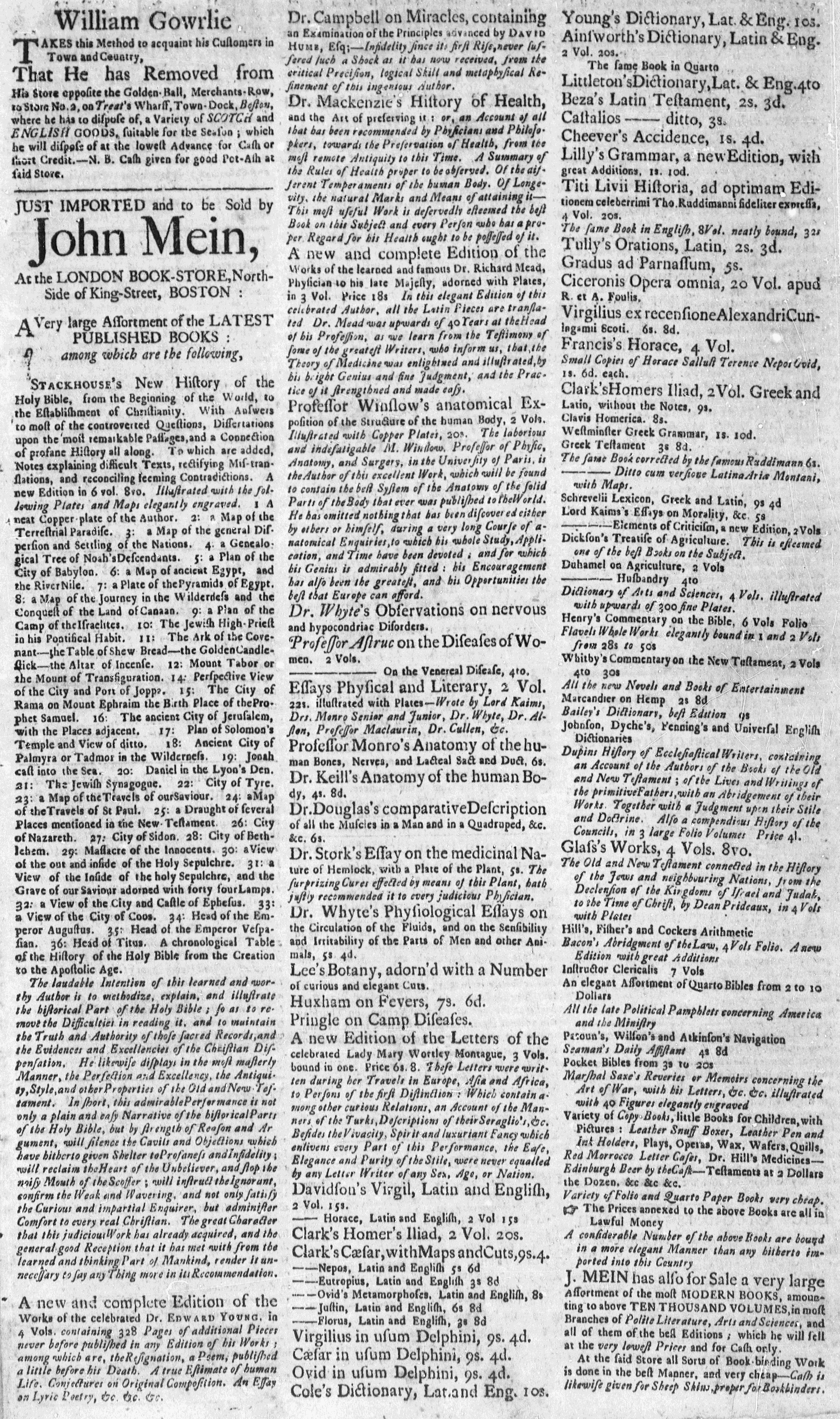What was advertised in a colonial American newspaper 250 years ago today?

“Catalogue of BOOKS, just imported from LONDON.”
For three weeks in November 1768 the partnership of Lathrop and Smith placed a full-page advertisement in the Connecticut Courant. It first appeared in the November 7 issue and again on November 14 and 21. Although Lathrop and Smith described themselves as “Apothecaries in Hartford,” they published a “Catalogue of BOOKS, just imported from LONDON” in their advertisement, listing approximately 250 titles available at their shop. To help prospective customers identify books of particular interest, they organized them by genre: Divinity, Law, Physick, School Books, History, and Miscellany.
While not unknown in the late colonial period, full-page advertisements were rare. They merited attention due to their size and the expense incurred by the advertisers. Given that the standard issue of most newspapers consisted of four pages created by printing on both sides of a broadsheet and folding it in half, full-page advertisements dominated any issue in which they appeared, accounting for one-quarter of the content. That was the case the first two times Lathrop and Smith published their book catalog in the Connecticut Courant. For its third and final insertion it comprised the second page of a half sheet supplement devoted entirely to advertisements. That supplement brought the number of pages distributed to subscribers up to six for the week. Lathrop and Smith’s advertisement still accounted for a significant proportion of content placed before readers. Its size may have prompted the printers to resort to a supplement in order to make room for other content.
In addition to filling all three columns, the first insertion also featured a nota bene printed in the right margin. “N.B. Said Lathrop & Smith, have for Sale as usual,” it advised, “A great Variety of little Cheap Books for Children.—A Variety of Tragedies, Comedies, Operas, &c.—Writing Paper, Dutch Quills, Scales & Dividers, A Universal Assortment of Medicines and Painters Colours.—Choice Bohea Tea, Chocolate, Coffee, Spices, Loafsugar, Indico, &c. &c. &c.” The nota bene may have also appeared in the subsequent insertions, but decisions about preservation and digitization of the original issues made at various points since they first circulated in colonial America may have hidden the nota bene from view.
Separate issues of the Connecticut Courant have been bound into a single volume. As a result, the original fold of the newspaper has been incorporated into the binding. This means that the inside margins are partially or completely obscured. Recall that the nota bene for Lathrop and Smith’s advertisement appeared in the right margin. That is the outside margin for odd-numbered pages, but the inside margin for even-numbered pages. The advertisement appeared on the third page when it was first published on November 7, making the nota bene quite visible, even in the volume of newspapers bound together. On November 14, however, it appeared on the fourth page. On November 21, it appeared on the second page of the supplement. In both instances the nota bene, if it remained part of the advertisement, became part of the inner margin, the portion of the page given over to binding issues together. It is impossible to tell from the photographs that have been digitized if the nota bene survived into subsequent insertions. Examination of the originals might reveal traces or confirm that it disappeared.
As the image for this advertisement makes clear, working with surrogate sources – whether microfilm or digitized images – sometimes has its limitations. Questions that cannot be answered from such sources might be addressed with more certainty when examining originals. If the nota bene was indeed discontinued after the first insertion, that raises interesting questions about the reasons. Did Lathrop and Smith request its removal? Or did the printers choose to eliminate it? What might this instance tell us about the consultation that took place between printers who produced newspapers and advertisers who paid to have their notices included in them?



